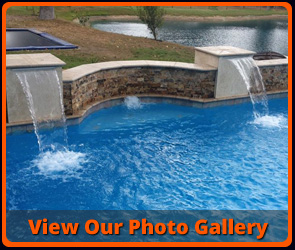The pool cleaning industry is set to reach a value of $2 billion in the near future. It’s no wonder, as the only way to really enjoy a swim is by keeping a pool clean and safe for use. But there’s an interesting trend that’s growing.
People are learning how to maintain a pool themselves. It starts with common maintenance, but people are also learning how to control pool pH levels with test kits, strips, and various chemicals.
But, what are the components involved in controlling pH levels, and what’s the complete process? Everything you need to know is in this article, so consider reading ahead!
Pool pH Level Explained
pH levels are the primary indicators for how acidic or basic a liquid containing is. The range starts from 0, or most acidic, to 14, or most basic. It’s worth noting that a liquid considered a base, that is one that reads above the value of 7, can still present serious dangers. For reference, bleaches and oven cleaners hover around a pH of 13.5, while grapefruit juice and tomato juice sit at a pH of 3.
In most cases, the closer a liquid containing water is to 7, the better. It’s the value with the least capacity for dangerous reactions, and is most compatible with life. pH is also an indicator of solubility and biological availability. Most importantly, however, it can provide information regarding how safe a body of water is for use.
Measuring a pool’s pH levels is essential, both for the people that want to swim, as well as all equipment involved in maintaining the pool. It’s a primary risk factor for damaged paint, rusted pool filters, algae proliferation, and much more. Keep reading this pool pH level guide to learn what components participate and how you can better monitor your pool’s pH levels.
Components That Affect Pool pH Levels
Of course, when it comes to pool maintenance, you’ve likely heard all about chlorine, chlorine tablets, algae killers, and filters. However, there are other components that come into play regarding pH levels. One often overlooked component is frequency of use; the more you swim, the more you’ll need to control pH levels.
Chlorine plays an interesting role and is usually used with cyanuric acid, also known as stabilizer. When used together, they’re more efficient at stabilizing a pool’s pH levels. These form the base that is common pool care. But, there are other chemicals that can participate. These include soda ash, muriatic acid, and sodium bisulfate.
What is the Right Pool pH Level
Unmonitored pool pH levels are an invitation to disaster, and keeping your pool safe is a priority. So, what is the right pool pH level? Well, you want to aim for a balanced pH of 7.2-7.6. It’s a range that’s comfortable for swimming, prevents algae proliferation, and won’t damage any equipment. What happens
If the pool’s pH climbs far above 7, you’ll start seeing some major issues. Swimmers can experience irritation, swelling, and itchiness on exposed skin or in their eyes. Worse yet, ingestion or eye exposure can lead to an urgent hospital visit. Health concerns aside, you might also get a summons for damages.
When a pool’s pH levels are too low, other problems start showing up. This usually creates an optimal environment for bacteria and other microorganisms that are also dangerous for swimmers. More alkaline levels also damage pool equipment.
Controlling Pool pH Levels
So, you now know the dangers of high and low pH levels. But, how do you monitor and control your pool’s pH levels? Typically, it’s with the same chemicals and components that affect the pool’s pH levels. Here’s a quick look at the impact from each one, and how to use them.
Necessary Equipment
Before getting started, you’ll want to ensure you have all necessary equipment. These are for both the user and the pool itself. The list includes safety goggles, gloves, soda ash, muriatic acid, dry acid, test kit and strips.
Test the Water First
Testing your pool’s pH level is the first step. To do this, you’ll need your test kit and strips. Here’s the process, from start to finish:
- Dip your test kit at least a foot deep into your pool.
- Pull it out and make sure both sample tubes reach the “fill” line.
- Add the indicated number of solution drops to the sample.
- Gently shake the kit.
- Use the reference colors on either side and compare them to the sample.
- Repeat steps 3 to 5 for the secondary sample.
- If both show optimal readings (7.2-7.6) your pool water is fine!
- If the readings are above or below the optimal readings, it’s time to add chemicals to stabilize the pH levels.
Soda Ash
Soda ash, also known as sodium carbonate, is used for raising a pool’s pH level. For proper use, you’ll want to add approximately two pounds for every 10,000 gallons of water. Start at the deeper end of the pool, slowly approaching the shallow end. It’s important to keep your filter running throughout the process, and leave it on for around two hours.
Don’t freak out when the water gets cloudy, as this is completely normal. It should clear up between 48 and 72 hours after application.
Muriatic Acid
Muriatic acid is used to reduce pH levels in a liquid, leading to a more alkaline or basic level. It kills mold, bacteria, and can remove stains and calcium deposits. The first step is to dilute the acid in water. This is a 1:10 ratio. So, you’ll want to pour half a gallon of muriatic acid in a 5 gallon bucket, and fill it to the brim with clean water.
Make sure your pool filter is running, and start pouring around the perimeter of the pool. It’s important that you wear the proper safety gear during the process, and avoid entering the pool for at least 30 minutes. After waiting between 4 and 5 hours, you have to test the pH levels again to see if they’ve stabilized.
Keeping Your Pool Safe
Now you have all the knowledge you need to keep your pool clean, safe, and more pristine than ever before. Getting all the equipment and organizing yourself might be difficult at first. But, once you get the hang of the process, you’ll be a pro at controlling pool pH levels in no time.
Your top priority should be safety, so make sure to wear protective gear throughout the entire process. Remember to measure properly and maintain the right ratios for each chemical!
Get in touch if you have any doubts or you’re interested in getting your pool set up from start to finish. We’re more than happy to manage the process for, and with, you!




